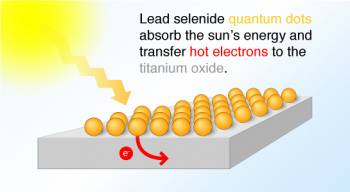Dec
16
Doubling Up On Photovoltaic Solar Cell Efficiency
December 16, 2011 | 2 Comments
Chemistry Professor Xiaoyang Zhu at The University of Texas at Austin has a method of photon harvesting significantly increasing the efficiency of conventional solar cells. The professor’s work improves the mechanisms of solar energy conversion.
Zhu and his team have discovered that it’s possible to double the number of electrons harvested from one photon of sunlight using an organic plastic semiconductor material. The team published their discovery Dec. 16 in Science.
Zhu explains saying, “Plastic semiconductor solar cell production has great advantages, one of which is low cost. Combined with the vast capabilities for molecular design and synthesis, our discovery opens the door to an exciting new approach for solar energy conversion, leading to much higher efficiencies.”
As the technology sits today the maximum theoretical efficiency of the silicon solar cell in use today is holding at approximately 31 percent. The rest of the sun’s energy hitting the cell is too high to be turned into usable electricity. That energy, in the form of “hot electrons,” is instead lost as heat. Harvesting the hot electrons instead of radiating of the heat could potentially increase the efficiency of solar-to-electric power conversion to as high as 66 percent.
About a year and a half ago Zhu and the team first came into the high efficiency through semiconductor nanocrystals, or quantum dots that are suggested for the cooling of hot electrons and can slow down the electrons. In a 2008 paper in Science, a research group from the University of Chicago showed this to be true unambiguously for colloidal semiconductor nanocrystals.
Zhu’s group discovered that hot electrons could be transferred from photo-excited lead selenide nanocrystals to an electron conductor made of widely used titanium dioxide.
Back in 2010 Zhu knew, “The demonstration of this hot electron transfer establishes that a highly efficient hot carrier solar cell is not just a theoretical concept, but an experimental possibility,” and that their methods will work for quantum dots made of other materials, too.
Getting to 66% isn’t a done deal as Zhu explains, “For one thing, that 66 % efficiency can only be achieved when highly focused sunlight is used, not just the raw sunlight that typically hits a solar panel. This creates problems when considering engineering a new material or device.”
To get to the theoretical goal, Zhu and his team have found an alternative. They discovered that a photon produces a dark quantum “shadow state” from which two electrons can then be efficiently captured to generate more energy in the semiconductor pentacene.
Working out the numbers on the pentacene mechanism shows an increase of solar cell efficiency to 44 percent without the need for focusing a solar beam, which would encourage more widespread use of solar technology.
That takes the efficiency more than a third of the way to 66%.
What’s known is a photon striking a pentacene semiconductor creates an excited electron-hole pair called an exciton. The exciton is coupled quantum mechanically to a dark “shadow state” called a multiexciton. This dark shadow state can be the most efficient source of two electrons via transfer to an electron acceptor material, such as fullerene, which Zhu’s group used in the study. Exploiting the dark shadow state to produce double the electrons should increase solar cell efficiency to 44 percent.
Zhu’s team was led by Wai-lun Chan, a postdoctoral fellow in Zhu’s group, with the help of postdoctoral fellows Manuel Ligges, Askat Jailaubekov, Loren Kaake and Luis Miaja-Avila.
The research shows there is still a huge jump to come in solar photovoltaic. Just how it will come to market isn’t clear, but the physics and chemistry are on their way to new defining potentials. Sixty six percent was a nutty idea not long ago, and how long it stands is open for more innovation and research.
Comments
2 Comments so far



Great article on the technology of solar power efficiency, which is the biggest key to it functionally. The rate between light interference and electron emittance is the key to the solar panel.
We are next to build an small pv system in our house and we are not sure about wich solar panel brand is better for us. We are thinking in SHARP or SunPower, anybody could suggest us?.
Thanks